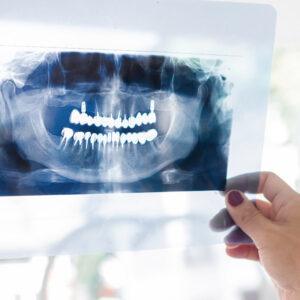
A dental X-ray machine is probably the most well-known piece of dental technology the average patient encounters. For over a century, X-rays have increased our understanding of the body and furthered the field of medical health, especially in dentistry. Dental X-rays allow dentists to see the inner health of your teeth and mouth in fine detail, meaning they can diagnose areas of decay or other internal problems and treat them early before they have a chance to cause greater harm. While dental X-rays necessarily involve radiation exposure, the levels are so low and targeted that the practice has long been proven safe for both adults and children alike.
What Are Dental X-Rays?
Dental X-rays are low-frequency radiation waves sent through your mouth with a dental X-ray machine. When attached to a specialized camera, the radiograph returns an image where softer tissues are more transparent, and the harder, denser materials like teeth and bone are brighter and clearer. The resulting image is an invaluable diagnostic tool that allows dentists to visually inspect the insides of your teeth and keep a permanent record of your oral health over time.
What Problems Can Dental X-Rays Detect?
Dental X-rays are most often used to diagnose cavities—areas of the enamel that are thinner due to decay will show up as “shadows” on the image of the tooth. However, dental X-rays can also be used to monitor oral health and the progression of healing after injury or surgery, identify swelling or inflammation that may indicate an infection or abscess, and determine if orthodontic treatment is necessary by examining impacted wisdom teeth before they erupt or the angle of misaligned teeth.
Types of Dental X-Rays
When sitting for dental X-rays, a patient might experience one or more of the following types:
- Bitewing X-Rays. These examine the crowns of the upper and lower teeth in one section of the mouth and help identify cavities and assess fillings in tough-to-reach areas.
- Occlusal X-Rays. Used to illustrate the arch of the teeth from either the top or bottom jaw.
- Periapical X-Rays. Display a tooth from the crown to the root to examine one or two teeth for root problems, cavities, and issues that affect the surrounding jaw bone.
- Panoramic X-Rays. Show the entire mouth and are often used to track a child’s tooth development to determine if orthodontics is necessary.
How Much Does a Dental X-Ray Cost?
Dental X-Rays are specialized dental tools, but they are also considered medically necessary as part of a typical oral healthcare regimen. As such, most oral radiography is covered by many insurance plans. However, while paying out of pocket, costs can vary.
Related: Patients who are part of Champagne Family Dentistry’s monthly membership plan get specialized pricing on dental X-rays and other preventive dentistry.
Are Dental X-Rays Safe?
It’s completely natural to wonder about dental X-ray safety, but dental X-ray machines use such low levels of radiation that there have never been any long-term negative effects reported from their use. Many patients will be given lead “bibs” or collars to wear as they have their radiographs done, which absorb errant radiation and protect other bodily tissues except those in the mouth.
Can You Get Dental X-Rays While Pregnant?
Pregnant women are the only exception to the safety of dental X-rays as they should avoid exposure to all radiation. Radiation is harmful to developing fetuses, and women who are pregnant or plan to become pregnant should tell their dentist before any scheduled X-ray treatments to ensure responsible dental care.
How Often Should You Get Dental X-Rays?
Dental X-rays are part of dentist-recommended preventive care and should be performed once per year. There is no special preparation required for getting dental radiography, and the results will be instant in the case of most dental X-ray machines. If you haven’t had your dental X-rays taken in a while, or have more questions about the process and risks of dental radiography, call Champagne Family Dentistry the premiere family dentist.

